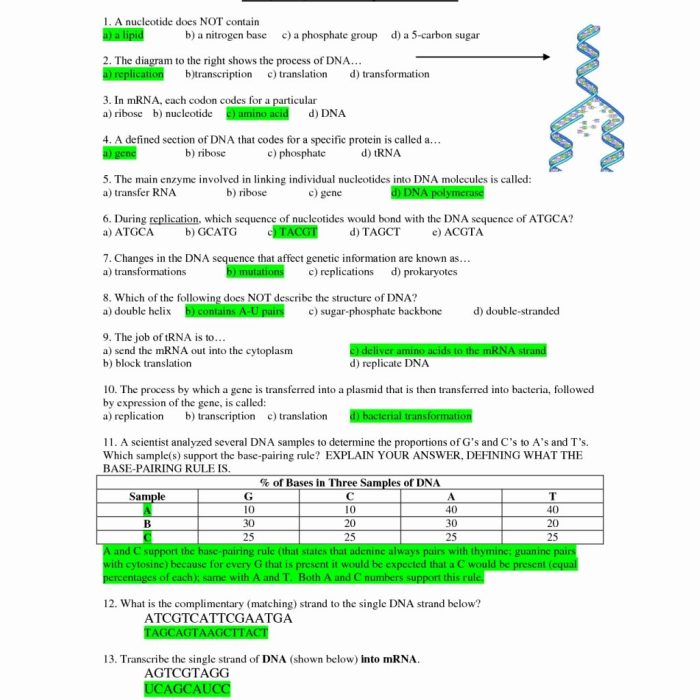Embark on a captivating exploration of practice dna structure and replication worksheet answers, delving into the fundamental principles that govern the very essence of life. This comprehensive guide unravels the intricacies of DNA’s structure and the remarkable process of replication, providing a profound understanding of the molecular machinery that underpins heredity and cellular function.
Through an engaging narrative, we delve into the fundamental concepts of DNA structure, deciphering its double helix architecture, nucleotide composition, and the significance of base pairing. We then embark on a detailed examination of DNA replication, illuminating the intricate steps of initiation, elongation, and termination, while highlighting the critical roles played by enzymes and proteins in this essential biological process.
Understanding DNA Structure

DNA (deoxyribonucleic acid) is a molecule that contains the instructions for an organism’s development and characteristics. It is a double helix, consisting of two strands twisted around each other.
Each strand is made up of nucleotides, which are composed of a sugar molecule, a phosphate molecule, and a nitrogenous base. There are four different types of nitrogenous bases: adenine (A), thymine (T), cytosine (C), and guanine (G).
The two strands of DNA are held together by hydrogen bonds between the nitrogenous bases. A always pairs with T, and C always pairs with G.
The sequence of nitrogenous bases in DNA determines the genetic code for an organism. This code is read by cells to produce proteins, which are the building blocks of life.
DNA Replication Process
DNA replication is the process by which a cell makes a copy of its DNA. This process is essential for cell division and for the transmission of genetic information from one generation to the next.
DNA replication begins when the DNA double helix unwinds and the two strands separate. Each strand then serves as a template for the synthesis of a new strand.
The synthesis of new DNA is carried out by an enzyme called DNA polymerase. DNA polymerase adds nucleotides to the growing strand in a 5′ to 3′ direction, following the base-pairing rules.
Once the new strands are synthesized, they are annealed to each other to form a new double helix.
Worksheet Analysis
The provided worksheet on DNA structure and replication covers the following key concepts:
- The structure of DNA
- The process of DNA replication
- The importance of DNA in genetic inheritance
The worksheet also includes a number of questions that test students’ understanding of these concepts.
The following are detailed answers to the worksheet questions:
- What is the shape of DNA?
- What are the four nitrogenous bases found in DNA?
- How are the two strands of DNA held together?
- What is the role of DNA polymerase in DNA replication?
- What is the importance of DNA in genetic inheritance?
DNA is a double helix.
The four nitrogenous bases found in DNA are adenine, thymine, cytosine, and guanine.
The two strands of DNA are held together by hydrogen bonds between the nitrogenous bases.
DNA polymerase is an enzyme that adds nucleotides to the growing strand in a 5′ to 3′ direction, following the base-pairing rules.
DNA contains the instructions for an organism’s development and characteristics. This information is passed from one generation to the next through DNA replication.
Applications of DNA Knowledge, Practice dna structure and replication worksheet answers
Understanding DNA structure and replication has a wide range of practical applications, including:
- Genetic engineering: DNA technology can be used to modify the genetic makeup of organisms, creating new varieties of plants and animals with desired traits.
- Forensics: DNA fingerprinting can be used to identify individuals from blood, hair, or other biological samples.
- Medical diagnosis: DNA testing can be used to diagnose genetic diseases and to determine a person’s risk of developing certain diseases.
DNA technology has also raised a number of ethical concerns, such as the potential for genetic discrimination and the use of genetic information for non-medical purposes.
Helpful Answers: Practice Dna Structure And Replication Worksheet Answers
What is the significance of DNA structure?
DNA structure is paramount for genetic inheritance and cellular processes. It determines the genetic code that governs the development and function of organisms.
How does DNA replication occur?
DNA replication involves the unwinding of the double helix, separation of strands, and synthesis of complementary strands, resulting in two identical copies of the original DNA molecule.
What are the applications of DNA knowledge?
DNA knowledge has revolutionized fields such as genetic engineering, forensics, and medical diagnosis, enabling genetic modifications, identification of individuals, and diagnosis of genetic disorders.